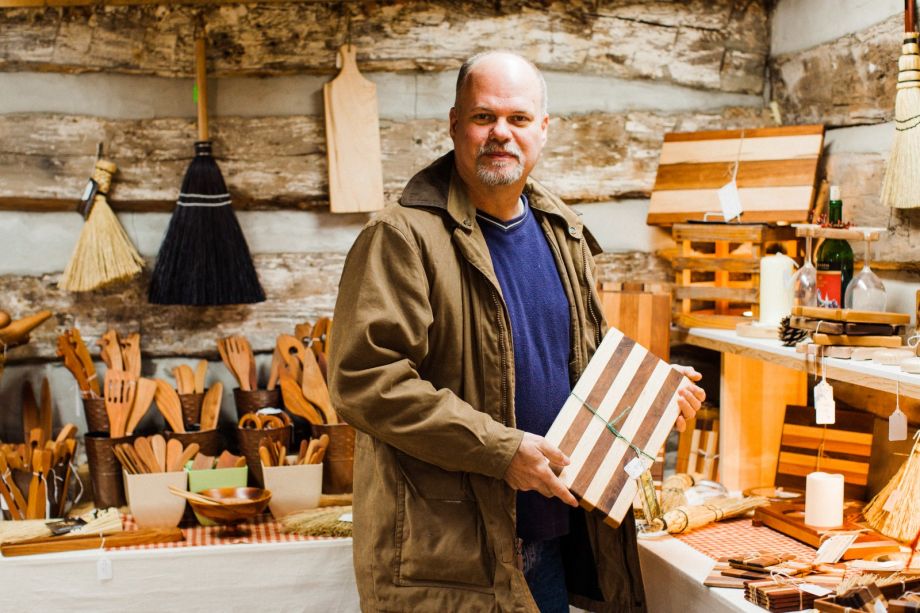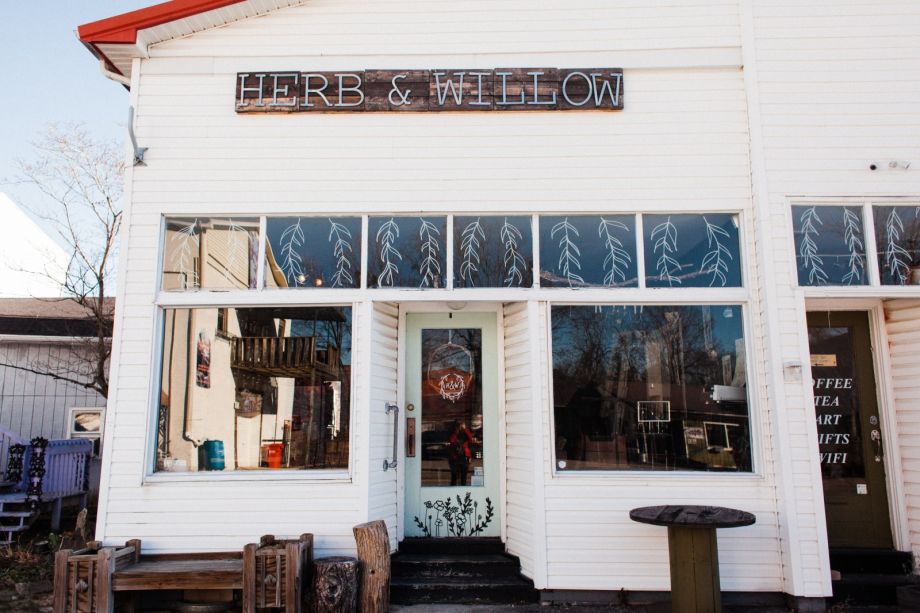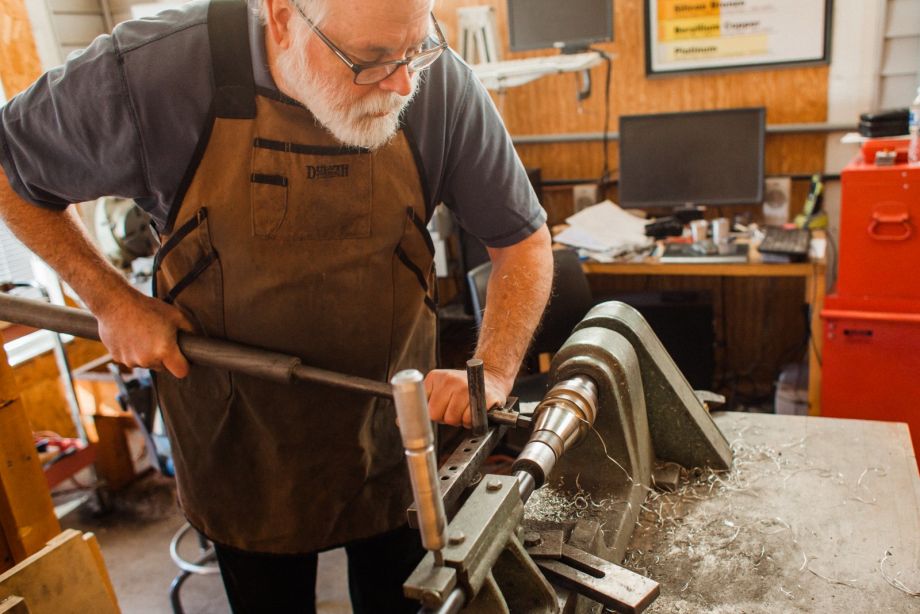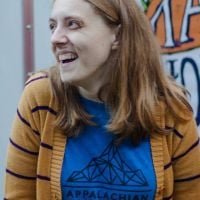Are You A Vanguard? Applications Now Open
Mayor Steve Connell and Diane Gilliam look at art in Gilliam Gallery & Studio.
Emily Moseley
This is your first of three free stories this month. Become a free or sustaining member to read unlimited articles, webinars and ebooks.
Become A MemberOne of the things people notice after spending any amount of time in Berea’s historic downtown is the density of galleries. For a small city in the foothills of the Appalachian Mountains, there are a lot of them. The state-designated “Folk Arts and Crafts Capital of Kentucky” attracts visual artists, ceramicists and traditional craftspeople just like Nashville lures country musicians, albeit on a smaller scale. In an old train depot, young creatives work alongside seasoned elders, displaying work in high-ceilinged workspaces. Visitors, some staying nearby at the stately white-columned Historic Boone Tavern Hotel, watch as pots are glazed and paintings are brought to life. Some days are busier than others but the growth is palpable. City officials count 40 galleries in total, and three new restaurants and a gallery-cafe have opened in the past two years — not a bad showing of entrepreneurship in a city of fewer than 20,000 people.
“I believe we can legitimately claim we’re a town where art’s alive because any visitor, almost any time of the year, will be able to encounter active arts in motion,” says Mayor Steve Connelly, who works in an office on the city’s main street in an old brick building that feels more like an old library than a place for politicking.
But it wasn’t always like this.
The little town that sprung up around Berea College — one of the first fully integrated colleges in the South — has journeyed a good many years to reach its current status: a rare growing, thriving city in a region that’s confronting steep population decline and rising rates of joblessness due in large part to the collapse of the coal industry. Eastern Kentucky alone has lost nearly 7,500 coal jobs since 2012, Kentucky Department for Energy Development and Independence records show, and in just the last two years, coal employment has decreased by 30 percent. The decline is largely due to plummeting natural gas prices and the energy industry’s move toward cleaner forms of production. In the towns, cities and counties where leaders are working to find a way forward, the search is on for a new export. This time, the hope is for something place-based that can keep the economy humming while encouraging businesses to invest locally. In Berea, that thing is art and culture.
Since 2010, the population of the city has grown by nearly 12 percent, making it one of the fastest growing places in the state, according to census data compiled by the Kentucky State Data Center at the University of Louisville. Local officials say Berea’s population continues to grow at a rate of 8 percent, which matches that of Lexington, the state’s second-largest city. Many of the cities closer in size and geography to Berea are hollowing out as young people leave to find opportunity elsewhere. With new people and businesses moving in, the city’s unemployment rate is four percent, compared to a statewide rate of five percent and a rate of seven percent in nearby communities, 2016 Census Bureau data shows.
It’s difficult to make a direct connection between any one economic strategy and growth, but local officials say that their investment in building an arts economy has paid off because it gives people a reason to stay. If they stay, they spend their money locally, and that money feeds back into the local economy.
In this time of economic upheaval, when the future of work looks nothing like its past and job insecurity is ubiquitous in rural places, it’s worth cultivating best practices from any and all available sources. It just so happens that Eastern Kentucky can look to a neighboring small city that took a chance on the arts, and it paid off.
The city of Berea began with its namesake college, founded in 1855 by John G. Fee around a vision of peace and acceptance among all people. Fee had a grand plan for the area, which until then had been an agricultural area called Glade. Being a radical Christian who took Jesus’ “love thy neighbor” instruction quite literally, Fee named his college Berea after a biblical town, and welcomed African-Americans and poor whites from Eastern Kentucky to live and learn together as equals.
Fee saw something of great value in the culture of the place and the people of Appalachia. The art they created, the music they made, the songs they sang, the dances they danced, the stories they told — all of it passed from generation to generation by word of mouth, rarely written down and recorded for subsequent generations’ sake.
Berea College would help the people of Eastern Kentucky preserve it all. Through hard times and better periods, the culture was largely unsupported by any local government entity until about a decade ago. It was at this time that the city began to recognize what Connelly refers to as its “artistic infrastructure,” and the need to invest in it.
“Art is active in Berea because of 125 years of uncoordinated and self-interested but mutually supportive activities by Berea College, individual artists, arts and craft organizations, and state government,” Connelly said in a speech during 2017’s Artists Thrive Summit, hosted by the Emily Hall Tremaine Foundation at Berea College. “In retrospect, the confluence of these unplanned common interests evolved erratically but ultimately settled into multiple layers of artistic infrastructure that have created the art experience that you have in Berea today.”

Woodturner Tim Wade shows some of his wares for sale at his gallery, The Cabin.
Connelly could be the official Berea historian. He holds the distinct threads of Berea’s stories in his mind and is able to deftly recall names of artists long since gone without so much as a pause. Give him the time and he’ll braid those threads together into a pattern easily recognizable as the foundation for all that Berea is today.
He’s been mayor for 15 years, long enough to help usher in the town’s renaissance as an arts and crafts capital, and to become well-known for his penchant for bow ties.
The walls of Connelly’s office are filled with old maps of Berea and various prints of owls — surely one or two painted by a Berea artist. A path between stacks of yellowing papers leads to the conference room, where a book about Lincoln sits on the shelf next to law dictionaries and paperback novels.
“Starting in the ’70s, and continuing into today, there was a sector that continuously invested in Berea, and that was the arts community,” Connelly says. “The artists were the ones that began to open up shops and invest. Those activities started a renaissance.”
The renaissance is more than 50 years in the making. In 1966, Interstate 75 cut through town, siphoning traffic from the town center, and making it much easier for locals to spend weekends 40 miles north in Lexington. Local businesses started to close. Walmart came to town, forcing the local grocery to close.
In the late 1970s and early 1980s, economic recession swept the country, and like many other small towns, Berea was facing a dire time of reflection. Elected leaders looked inward, searching for anything they could use to bolster their local economy. Local businesses were closing and people were leaving town to find work elsewhere. In Eastern Kentucky, a bust cycle ripping through the local coal industry added another layer of tumult.
It didn’t take long for local officials to recognize that Berea’s greatest local asset was its arts community, something that had been woven into the fabric of the town since the very beginning.
Local artists were investing in Berea in big ways: by opening galleries and weaving shops, making and selling art, and starting local festivals that continue today.
They were doing it largely on their own with little to no help from the government or Berea College. They were doing it because there was energy and synergy behind their efforts — a confluence of creativity and economy that city commissioners saw as an investment worth making.
In 1982, the City Commission passed a hotel/motel tax and started a tourism commission. The World’s Fair was in Knoxville that year, and Berea wanted to catch I-75 travelers on their way south. The commission passed a 3 percent tax, and from 1982 to 2007, the all-volunteer tourism commission received about $125,000 a year from the tax.
Further tax reform was made in 2007 during the Great Recession when Berea raised its property tax rate from the lowest in the state at .03 percent, to 10 percent. Soon after, they instituted a 3 percent restaurant tax, and the tourism budget quickly shot up to nearly one million dollars a year.
Berea then hired full-time staff for the Tourism Commission for the first time in its history, and with their budget in place, the commission was able to officially advertise Berea as the Capital of Arts and Crafts. With the advertising came tourists, and with the tourists came economic activity that bolstered the community in more sustainable ways.
Berea Economic Development Director Danny Isaacs describes the decision to move away from traditional industries and look to the arts as a economic engine as one of sheer logic. When city officials stepped back and evaluated where they could make strategic investments that would have the greatest impact, arts and crafts was the clear choice.
“[Economic growth] goes back to building on what you have and what you’re known for,” Isaacs says. “For Berea, the natural choice was arts and crafts. It’s been a part of the cultural fabric in Berea for longer than any of us have been around.”
In the early 2000s, the growth of the internet and online shopping decreased arts and crafts sales. Aging artists who helped build Berea’s arts and crafts brand began to retire, leaving empty galleries and storefronts in “Old Town.” Young working artists being trained at Berea College were taking their talent and potential economic contributions out of Berea after graduation.
Once again, the city took stock of its economic situation, and officials saw the need to invest in local arts. However, this time it became clear there was a gap in business training and support for working artists.
In 2013, city officials approached the Mountain Association for Community Economic Development, a local nonprofit where I work, to discuss options to reinvigorate Old Town through more investment in an arts economy. The nonprofit helped draft the idea for the Berea Artist Accelerator, a 16-month artist training program, and enrolled its first class of five artists in 2014.
The program provides work and gallery space in a renovated casket factory in Old Town called Gallery 123. It also provides business training and a monthly stipend to help artists stay on their feet until they can hopefully start their own business someday. The Artist Accelerator program has graduated 18 artists since 2014, and in the fall, enrolled a new class of three local artists.
“We wanted to do something to give people a start,” says Kerri Hensley, the executive director of the Berea Tourist and Convention Commission.
Hensley’s office is in the old L&N train station. She sits flanked by nearly floor-to-ceiling windows that look out on the train tracks behind the building. The trains still run through town, though with much less frequency and without passengers.
Artists chat with Hensley when she enters their galleries, some of which are next door to the old depot. She asks about their spouses. They give reports about the upcoming holiday season, one of the busiest times of the year for Berea’s working artists. They know she is their advocate; she helps them keep the lights on and the doors open.
She knows how important the arts are to Berea’s overall economic success. The culture brings tourists to town, who will hopefully stay for a weekend and truly experience Berea’s swiftly growing local restaurant scene.
“I always tell people that arts is our Big Mac,” Hensley says. “That’s what we’re known for and that’s what we’ll always be known for.”
Walking from the gallery and workspace of a local jeweler back to her window-walled office, Hensley points out a newly-opened gallery space, The Cabin. Woodturner Tim Wade sells his oak, cherry and zebra wood bowls, kitchen utensils, and wooden snowmen within. He is a recent graduate of the Berea Artist Accelerator.

Herb & Willow, a part coffee shop, part art gallery, allows local artists to display and sell their work.
The physical cabin in which his gallery space resides is an original 1813 cabin where one of the first settler families in Berea lived. It’s one room, about 500 square feet, with a long, deep porch that welcomes visitors inside. Broom corn grows next to the porch, and cold drinks are available inside.
He leases it from the city — an arrangement that Wade thinks was an easier sell because he went through the Artist Accelerator program.
“I guarantee you, had I not went through the program, I feel that I would not have been given this opportunity to be down here,” Wade says. “[The city commissioners] got to know me so they felt comfortable taking a chance on me.”
Wade worked as a medical lab tech for 26 and a half years, eventually working his way up to lab supervisor at a Lexington hospital.
“I tell people I climbed the ladder, then jumped off,” Wade says. The stress of the job started to get to him. He wanted to see people on their best days instead of their worst. He wanted to do something he enjoyed — something that, if all money was eradicated tomorrow, he would continue to do anyway. For him, that thing was woodturning.
It had been a lifelong hobby — a stress reliever. He sold some things here and there but never thought about turning it into a business until interest in his products began to grow.
“It came to pass that people started liking it,” Wade says. “I was kind of taken back from it because I never really thought my stuff was good enough to sell.”
Wade is a numbers guy. He counts every customer who walks through his door on a handheld ticker. He knows he sold exactly 237 wooden snowmen in 2016; it’s an item for which he’s locally known. One local woman — “Bless her heart,” Wade says — has bought dozens for herself and her family members, and buys a new one every year.
He’s studied business tips to get customers into his gallery. Offering cold drinks (he researched which brand is most popular, and stocks his mini-fridge with that brand) in an area of town currently without restaurants within walking distance is one way he does this; the colors he chose for his logo was another.
He currently has multiple wholesale contracts across Kentucky, four of which are in Berea. He’s taking more time now to grow his business, which he hopes to keep open for as long as he keeps turning wood. His plan is to build personal connections with anyone who walks into The Cabin so they keep coming back, and tell their friends and family to come, too. He gives his customers his full attention while they browse the bowls, coasters and utensils; it’s clear he finds great joy in getting to know them.
“I am very fortunate to do what I like and do it in a town that encourages it,” Wade says. “It would be very hard to have a business in a town that was maybe not more known for [the arts]. I’m sure you could do it, but it doesn’t have the draw that Berea has. Therefore, people come here just for this type of stuff that I do.”
Artists in the program also have access to technical assistance and small business financing through MACED — two things that can be vital to keeping a business running.
“None of [the artists] lack talent but they may not have experience in the business aspect,” Hensley says. That’s why when the Artist Accelerator program began, a core component was making business training classes available to enrollees through MACED. These classes teach artists the aspects of running a business they likely didn’t learn in art school — skills that are necessary to become and remain successful.
Artists aren’t the only ones taking these classes, either. Isaacs says the training program began with about 20 enrollees, and only a portion of them identified as artists. Some of the more successful businesses to come out of the program are restaurants, he says.
“What we’re not seeing is the next McDonald’s franchise operator coming out of one of our business training programs,” Isaacs says. “But you are seeing someone who wants to embrace local foods and someone who has an appreciation for local art, and it all just kind of fits together.”
Three local restaurants have opened in the past two years: Clementine’s Bake Shop, Native Bagel Co., and Noodle Nirvana. The owners of these restaurants have all participated in business training classes offered in Berea. A coffee and tea shop, Herb & Willow, also opened. It’s part coffee shop, part art gallery, and provides space where local artists display and sell their work. The owner is a graduate of the Artist Accelerator program. Apollo’s, a regional chain pizzeria, is coming to Old Town in early 2018.

Artist Ken Gastineau works on a project in his studio. When Gastineau first moved from Santa Fe to Berea in 1987, he was one of only a few artists working in Old Town.
“What we’re seeing is success breeds other success,” Isaacs says. People see entrepreneurs opening businesses and finding success, and they become more willing to take risks themselves. “It gives other folks the same sort of confidence.”
More and more people have enrolled in the business training program every year. Isaacs says if 50 people go through the program in one year, Berea will likely see two to three businesses come out of that. In a town of 15,000, two to three new small businesses a year can be meaningful, he says.
“We’re still looking at commercial development opportunities, but those are the home runs, and you win a lot of games hitting a bunch of singles,” Isaacs says. “For us, small business development and entrepreneurship is our strategy of hitting singles. And we’re seeing a bunch of those while we’re prepping ourselves for home runs.”
The vision: to build a thriving local economy where creativity isn’t just a piece of what happens, but is fully integrated in any economic endeavor.
“When you find communities who have a natural inclination for making and creativity, if you can spread that into the rest of your community, it just helps bring groups together,” says Beth Flowers of the AIR Institute of Berea College. “It helps motivate those that are stuck in their traditional way of doing things to get out of that rut, and help with the reality of the new economy we’re facing, which is so confusing for most people.”
The AIR Institute has developed a curriculum to help build community capacity for the arts through trainings that help locals implement the program. AIR is the only program in the country that trains artists with other members of the community, which is a radical shift in most communities. By educating artists with people from other sectors, AIR aims to help art entrepreneurs achieve success and expand community understanding of artists as valuable, strategic contributors to a thriving local economy.
“In the scheme of things, given the state of the world these days, the reason to make art and the reason to develop creativity is because things are troubled,” Flowers says. “If we don’t find more ways to connect people who are not connected, our communities fail.”
Flowers visited Berea in 2014 to share the AIR curriculum. On that trip, she met then-director of Berea Tourism, Belle Jackson, as well as the inaugural class of artists in the Artist Accelerator program.
“‘There is something crazy, magic here in Berea,’” Flowers recalls saying to herself. It seemed that the stars had been forced to align in Berea, and several local efforts were converging around rebuilding the city as a creative placemaking mecca. Flowers knew she had to bring the AIR Institute into the fold. Soon enough, she discovered she has Kentucky roots. Her mother’s ancestors lived near the Clays — a family of abolitionists and great compromisers. One ancestor married the son of John G. Fee, the founder of Berea College. It seemed the stars were aligning for Flowers, too.
“It just feels like I was drawn here, and there’s work to be done,” Flowers says. “It’s very humbling.”
In Berea, AIR started to train people from within the community to teach the curriculum themselves. Flowers insists the curriculum is “not in any way fancy, or rocket science.” It’s simply a process that can be adapted to any community to help design a path forward toward rebuilding.
“AIR says, ‘You already know what the program is, but you have to figure it out yourself. There’s nobody here that’s going to save you, there’s nobody here who’s going to tell you what the answer is,’” Flowers says. “All we’re giving you is an opportunity to come together, to let go of some stuff, clear the air, find common ground, and give you a framework for collaboration and some common language that you can use and make your own in whatever way is appropriate to you.”
AIR’s vision of spreading to other communities will soon be realized. The Kentucky Community and Technical College System is part of the implementation of AIR, along with MACED. In the near future, the curriculum will be made available at community colleges across the state. Communities across Eastern Kentucky will have access to the process of rebuilding creative places that will thrive far into the future.
“We don’t know at all where the economy is going,” Flowers says. “There is no way that we can pretend to know what skills people will need, except for one, which is to be a creative thinker, to be able to understand process and to be able to imagine solutions.”
Imagining solutions for a post-coal Appalachia is the work of many, and the most ardent arts economy booster knows that even the most charming gallery district can’t sustain an entire workforce — but maybe the infrastructure supporting that district can. Or, at least that’s what Connelly is hoping.
“It is the confluence of unplanned common interest that has evolved erratically and ultimately settled into multiple layers of artistic infrastructure,” Connelly says. “That’s what we’ve got, and it wasn’t planned, it wasn’t mapped out. It has accrued and we’re trying to nurture it. We’re trying to add another layer. We’re trying to refine and support and keep it.”
It’s certainly a story worthy of catalog in the mind of Mayor Connelly, right next to the names of past Berea artists upon which the city’s future now stands.

Ivy Brashear is the Appalachian Transition Coordinator at the Mountain Association for Community Economic Development in Berea, Kentucky. She has written for Spotlight on Poverty and Opportunity, Huffington Post, and Yes! Magazine.
Emily Moseley is a photographer from Denver, Colorado. She received her BFA in Photography from the University of Colorado-Denver, and then moved to Seattle, Washington, where she met her husband, a Lexington native. In 2010 they relocated to Lexington, where they currently live with their dog. Emily runs a photography business, Emily Moseley Photography, that specializes in weddings and family photography.

20th Anniversary Solutions of the Year magazine